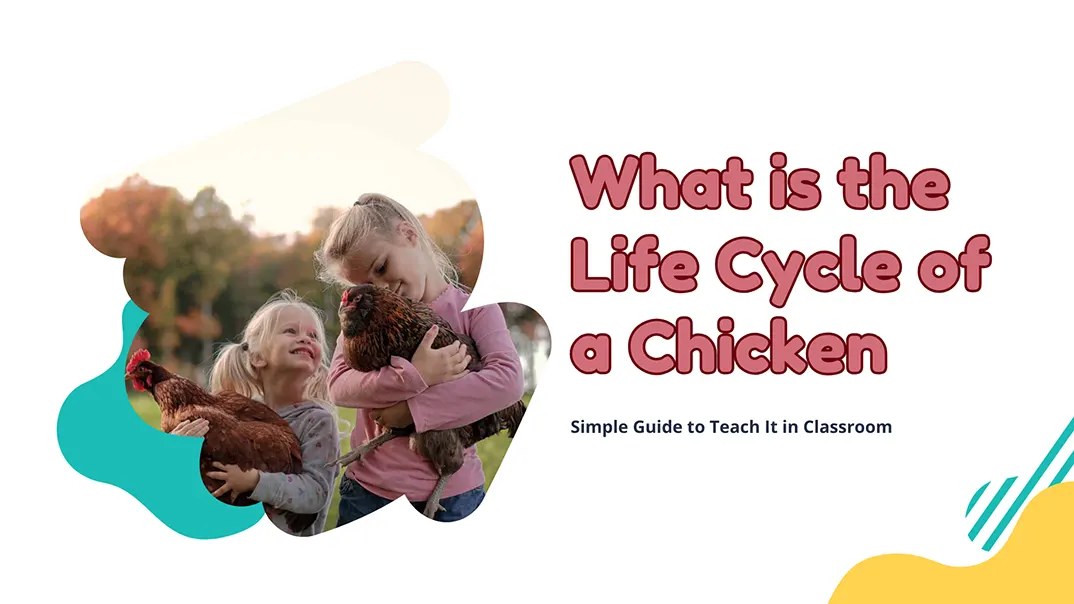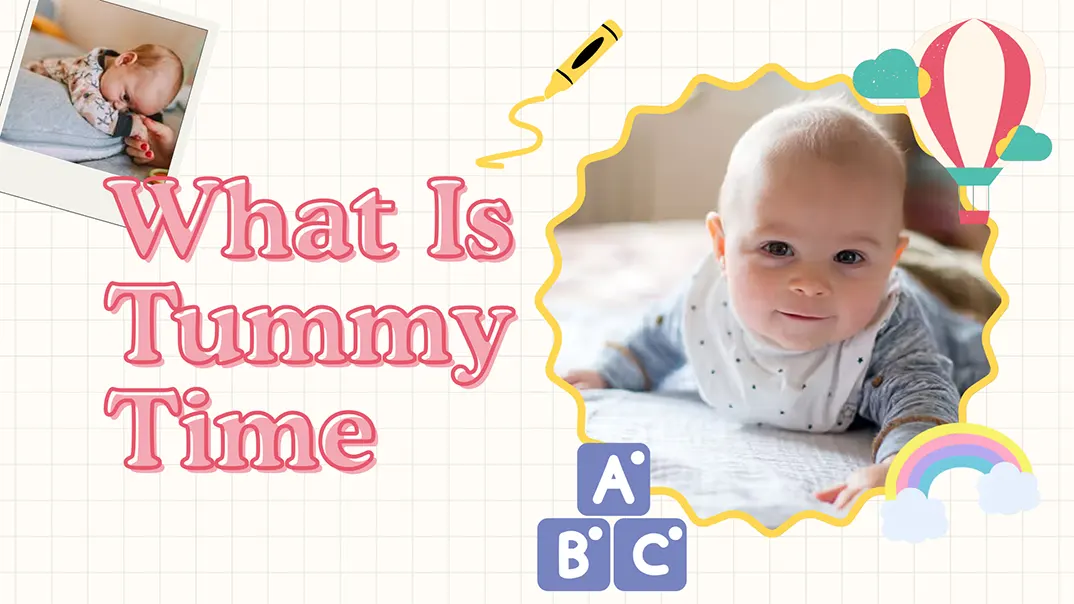Are you torn between the Reggio Emilia and Montessori approaches for your child’s education? With so many educational methods available, deciding which one will truly support your child’s growth and development can be difficult. Do these two popular philosophies align with your goals as a parent or educator?
The debate between the Reggio Emilia and Montessori approaches is a key point of discussion in the world of early childhood education. Both educational systems aim to develop the child holistically, but they differ in their methods, philosophies, and classroom structures. Understanding these differences is crucial for educators, parents, and anyone interested in child development.
This article will explore each of the core aspects of these two educational models. Let you know Reggio Emilia vs Montessori, which one more suitable for you.
Reggio Emilia vs Montessori
Education is a powerful tool that shapes the future, and two of the most widely recognized and influential approaches are Reggio Emilia and Montessori. Both approaches emphasize respect for the child, the importance of fostering independence, and the need for learning environments that stimulate curiosity and creativity. While they share common values, they are rooted in distinct educational philosophies that offer unique pathways for children’s development.
Reggio Emilia vs Montessori: A Brief Overview
| Aspect | Montessori | Reggio Emilia |
|---|---|---|
| Philosophy | Child-centered, emphasizing self-directed learning. | Child-centered, focusing on exploration, expression, and collaboration. |
| Role of the Teacher | Teacher as a guide or facilitator. | Teacher as a co-learner and collaborator. |
| Learning Environment | Prepared environment with carefully selected Montessori materials. | Flexible and creative environment with materials that invite exploration. |
| Approach to Learning | Focus on independent learning and mastery of specific skills. | Focus on exploration, project-based learning, and social interaction. |
| Parent Involvement | Parents as partners in the child’s development, with regular updates. | Parents as active participants in the learning process, often involved in projects. |
| Social Interaction | Emphasis on individual work, though social interaction is encouraged. | High emphasis on social learning, collaboration, and group projects. |
| Development Focus | Cognitive, physical, and social development through structured tasks. | Holistic development, focuse on emotional, social, cognitive, and creative growth. |
| Age Range | Typically 3-6 years (though Montessori can extend from infancy to adolescence). | Primarily for children 3-6 years, though can extend into primary school. |
What is Reggio Emilia Education?
Reggio Emilia is an educational philosophy that originated in Italy after World War II. It was developed by Loris Malaguzzi and is centered around the belief that children are capable, competent, and curious learners. In Reggio Emilia, the learning environment is seen as the “third teacher,” where the physical space, resources, and teacher-child interactions all play a crucial role in the child’s learning experience. The approach emphasizes project-based learning, where children are encouraged to explore, experiment, and investigate topics that interest them. Reggio Emilia also places significant importance on the role of families and the community, viewing education as a collaborative process between children, parents, and educators.
What is Montessori Education?
Montessori education, founded by Dr. Maria Montessori in the early 1900s, is grounded in the belief that children learn best when they are allowed to explore and discover independently within a structured environment. Montessori’s methods are based on the observation of children’s natural development, providing them with materials and activities that cater to their individual learning needs. The Montessori approach emphasizes self-directed learning, where children choose their activities from a range of developmentally appropriate options. Teachers are seen as guides who facilitate learning by observing each child’s needs and interests, providing tailored support. Montessori classrooms are characterized by an orderly, aesthetically pleasing environment that encourages independence and self-discipline.
Montessori vs Reggio Emilia: A Comparative Perspective on Curriculum Approaches
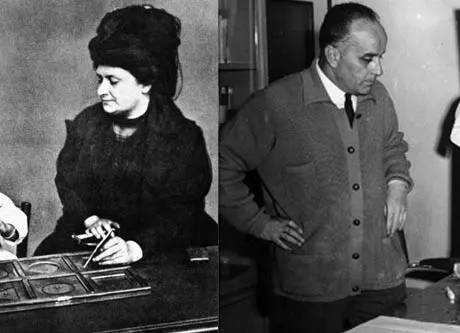
The goal of the Montessori program is to help them develop a sound personality. The goal of the Reggio program is to enable children to acquire representational experiences and construct meaning about the external world in a variety of ways, so that children can be healthy in a stimulating environment.
The Curriculum Perspectives of Montessori
- Curriculum Goals:
In Montessori education, the curriculum is designed to help children develop cognitive, social, emotional, and physical skills at their own pace. The primary goal is to foster independence, self-discipline, and a love of learning. Montessori educators believe that children should be given the freedom to choose activities that interest them, which in turn allows them to develop concentration, problem-solving skills, and self-control. The curriculum is based on the understanding that children’s developmental stages are universal, and therefore, Montessori materials are structured to support specific developmental milestones. - Curriculum Content:
The Montessori curriculum includes practical life skills, sensorial activities, mathematics, language, cultural studies, and the arts. Practical life activities involve tasks like cleaning, cooking, or taking care of plants, which help children develop coordination, concentration, and independence. Sensorial activities help children refine their senses through materials that highlight different colors, shapes, textures, sounds, and sizes. Mathematics and language are taught using concrete materials, such as number rods and sandpaper letters, that allow children to manipulate and understand abstract concepts. - Curriculum Implementation:
Montessori classrooms are carefully prepared to be child-centered environments. The materials are arranged in a way that encourages exploration and independence. Children are free to choose activities that interest them, and teachers observe their progress and intervene only when necessary to guide the learning process. The classroom is designed to encourage independence, allowing children to take ownership of their learning.
The Curriculum Perspectives of Reggio Emilia
- Curriculum Goals:
The curriculum in Reggio Emilia is not predefined but emerges from the interests, curiosities, and questions of the children. The goal is to foster creativity, critical thinking, and problem-solving skills. Reggio Emilia places a strong emphasis on emotional and social development, encouraging children to communicate their thoughts and feelings, work collaboratively, and solve problems together. The curriculum is child-centered, with learning being driven by the interests of the children rather than a set series of lessons. - Curriculum Contents:
Reggio Emilia’s curriculum is interdisciplinary and flexible. It includes art, language, science, mathematics, and social studies, but the content is largely driven by the children’s inquiries. Projects—often long-term, in-depth studies of topics that interest the children—form the heart of the curriculum. These projects might involve exploring nature, investigating a community issue, or studying a particular cultural concept. Children’s artwork, documentation of their process, and group discussions are integral parts of the curriculum. - Curriculum Implementation:
In Reggio Emilia, teachers act as facilitators, supporting children’s exploration and guiding them through their inquiries. The environment is intentionally designed to be an extension of the classroom, often featuring materials that can be manipulated or transformed by the children. Learning is viewed as a dynamic process, with teachers documenting the children’s progress and using this documentation to guide the next steps in the learning journey. The role of families is also crucial in the Reggio Emilia approach, with parents seen as partners in the educational process.
Teacher’s Role in Reggio Emilia vs Montessori
Teachers play a crucial role in shaping the educational experience and development of children. They are not only transmitters of knowledge but also guides, mentors, and facilitators who foster a positive learning environment.

In both Reggio Emilia and Montessori approaches, teachers are seen as active participants in the learning process, collaborating with children to co-construct knowledge. They observe, listen, and support children’s inquiries, providing the resources and guidance needed to nurture curiosity, critical thinking, and independence. A teacher’s ability to understand and respond to each child’s needs, interests, and developmental stage is key to fostering a love for learning and helping children reach their full potential.
Teacher’s Role in Reggio Emilia
In the Reggio Emilia approach, the teacher’s role is to be a co-learner and a facilitator of the children’s inquiries. Teachers work alongside the children, guiding them in their projects, helping them develop their ideas, and documenting their learning. They observe the children closely to understand their interests and provide materials or provocations that will encourage deeper exploration.
Teachers in Reggio Emilia classrooms also act as communicators, often sharing the children’s work with families and the larger community. Reggio Emilia teachers do not see themselves as the primary source of knowledge. Instead, they view their role as collaborators in the learning process, co-creating knowledge with the children. Teachers are deeply attuned to the children’s emotional needs and ensure that the classroom environment fosters positive social interactions, creativity, and critical thinking.
Teacher’s Role in Montessori
In Montessori education, the teacher is known as a “guide” or “directress” rather than an instructor. The role of the Montessori teacher is to observe each child’s developmental needs and offer materials and activities that match their abilities and interests. Teachers are responsible for creating an environment that encourages independence, freedom, and self-direction. They prepare the classroom, introduce new materials, and provide the children with opportunities to engage with the materials in ways that promote active learning.
Montessori teachers also observe the children closely, but they intervene less than in Reggio Emilia classrooms, allowing children to work independently or with their peers. Teachers are there to offer support when needed, guiding children through challenges and encouraging them to develop problem-solving skills. The goal is to help children become self-reliant, confident learners who take responsibility for their educational journey.
The Classroom Environment: Reggio Emilia vs Montessori
The Montessori Classroom Environment
Montessori classrooms are typically very organized and minimalist. Materials are neatly arranged and easily accessible, with each item having a specific place. This sense of order helps children develop a sense of responsibility and fosters concentration. The simplicity of the environment also encourages children to focus on the task at hand rather than distractions. Furniture in a Montessori classroom is designed to be child-sized, allowing children to move freely and independently. Tables, chairs, shelves, and other pieces are scaled to the child’s height and abilities.

The arrangement of the furniture promotes movement and freedom, enabling children to choose activities that interest them and to work at their own pace. Montessori classrooms are divided into different “learning stations” or areas, each dedicated to specific types of learning. These areas may include practical life activities, sensory exploration, mathematics, language, geography, science, and the arts. Materials are organized within each area to encourage independent exploration and learning. Montessori classrooms are filled with a variety of hands-on materials that are designed to be self-correcting. These materials allow children to engage in active learning through manipulation, which helps them internalize concepts and develop problem-solving skills. Each material is purposeful and carefully chosen to support the child’s developmental stage.
The Reggio Emilia Environment
The Reggio Emilia environment is known for its use of natural materials, soft lighting, and aesthetically pleasing design. Classrooms often feature wood, fabric, plants, and natural objects, creating a warm and inviting atmosphere. The materials are open-ended, allowing children to explore and create with them in multiple ways. Art materials such as clay, paint, and fabric are readily available, fostering creative expression.

Unlike the structured environment of Montessori, Reggio Emilia classrooms tend to be more flexible and dynamic. The space is designed to be adaptable, allowing it to evolve as children’s interests and projects develop. Furniture is often movable, and the classroom may change its layout depending on the current focus or project. This flexibility enables children to engage in collaborative work, group discussions, and exploration, with the room serving as an extension of their ideas.
Reggio Emilia classrooms are organized into different zones or spaces that are tailored to various types of activities. These might include art spaces, writing corners, construction areas, and quiet reading corners. Materials are placed within reach, and there is an emphasis on creating a balanced environment that promotes both individual and group work.
In Reggio Emilia classroom walls are often adorned with displays of children’s work and documentation of their learning process. Photographs, drawings, and written reflections are displayed to honor the children’s ideas and to make their learning visible. This documentation not only celebrates the children’s efforts but also serves as a tool for reflection and further inquiry.
How the Environment Helps Children Grow
Both the Reggio Emilia and Montessori environments are designed to facilitate the growth of children in different but complementary ways.

While the Montessori classroom focuses on fostering independence and self-discipline through a structured, orderly environment, the Reggio Emilia environment promotes creativity, collaboration, and critical thinking by providing a more flexible, dynamic space. In both approaches, the environment plays a crucial role in supporting children’s development. In Montessori, the environment encourages exploration and self-discovery, allowing children to engage with materials that match their developmental stage. The orderliness of the environment supports focus and concentration, fostering a deep love of learning. In Reggio Emilia, the environment stimulates curiosity and creativity, with an emphasis on collaboration and communication. Both environments provide opportunities for children to develop their cognitive, emotional, and social skills in ways that are authentic and meaningful to them.
The Role of the Child in Reggio Emilia and Montessori
Both the Reggio Emilia and Montessori approaches view children as active participants in their own learning, but they differ in how they perceive and support the child’s role in the learning process.
The Role of the Child in Reggio Emilia
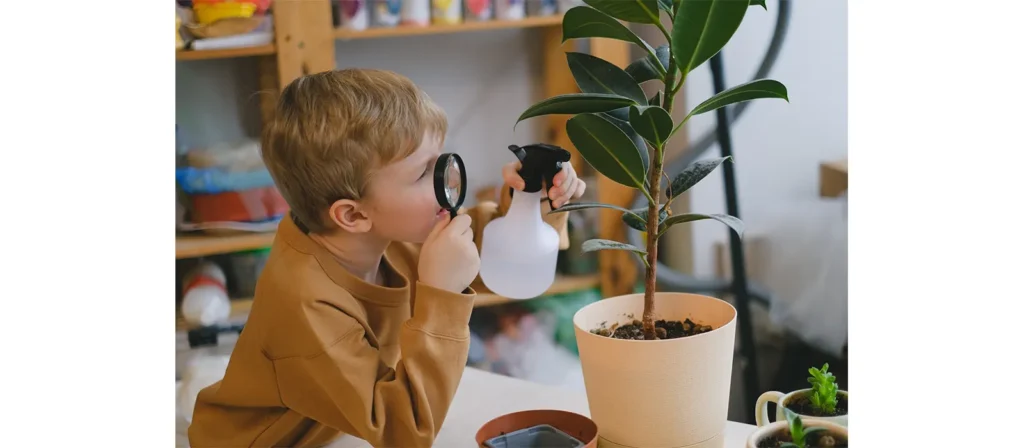
In Reggio Emilia, the child is seen as a capable, competent, and curious learner who is actively involved in constructing their own knowledge. Children are viewed as collaborators in the learning process, working together with peers, teachers, and the environment to explore ideas, solve problems, and create meaning. They are encouraged to ask questions, express their thoughts and emotions, and take ownership of their learning.
The role of the child in Reggio Emilia is not limited to passive learning; rather, it is an active process of inquiry, exploration, and discovery. Children are encouraged to take risks, experiment, and communicate their findings. Teachers provide the support and resources necessary for children to engage with the environment in meaningful ways, helping them reflect on their experiences and develop deeper understandings.
The Role of the Child in Montessori

In Montessori, the child is also seen as an active learner, but the emphasis is more on independence and self-direction. The Montessori approach values the child’s ability to choose their own activities and work at their own pace. The child’s role is to engage with the materials, practice skills, and develop a sense of responsibility and discipline.
Montessori classrooms are designed to encourage autonomy, allowing children to make decisions about what to work on and how to approach tasks. Teachers in Montessori environments are there to guide, observe, and offer support, but the child’s role is central to the learning process. The child is seen as capable of directing their own learning, with teachers providing the tools and guidance to help them grow.
Montessori Furniture vs Reggio Emilia Furniture
Montessori Furniture
In Montessori, furniture is carefully selected to promote independence and self-sufficiency. It is designed to be child-sized, allowing children to easily access materials and perform tasks independently. Montessori furniture includes low tables, child-sized chairs, shelves that are within reach, and workstations that are accessible to children. The furniture is designed to promote order, with each item having a designated place. This helps children develop a sense of responsibility and fosters a calm, orderly learning environment.
1. Montessori Tables and Chairs
The tables and chairs are designed to be the right size for children, encouraging them to sit comfortably and engage in activities independently without adult assistance. By having their own workspace, children learn to organize their materials and focus on their tasks, fostering a sense of responsibility and self-discipline. The simplicity and modular design allow for various activities, whether it’s art, reading, or group work, making the space versatile and adaptable to different needs. Ergonomically designed, these tables and chairs encourage children to sit properly, promoting healthy posture habits.
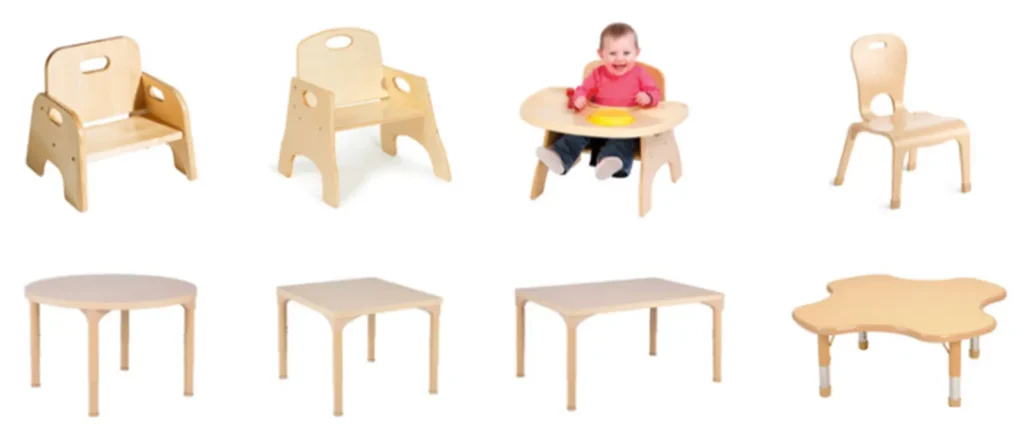
2. Montessori Bookshelves
Low, open bookshelves allow children to independently choose their own books, helping to foster a love of reading and personal responsibility for their own learning. The open design encourages children to put books back in their designated spots, teaching them to organize and care for their belongings. Bookshelves are often arranged with covers facing out, making it easy for children to visually engage with the materials and select books based on interest. Children can access books whenever they need, enhancing their ability to make choices and take ownership of their learning process.

3. Montessori Storage Cabinets
These cabinets are designed with child-friendly storage solutions, encouraging children to keep their learning materials tidy and organized. With lower shelving and open compartments, children can access and return materials independently, which fosters autonomy and decision-making skills. Children learn to manage their belongings, understand the importance of cleanliness, and develop habits of organization. Montessori storage cabinets are often designed to be compact and efficient, helping to maximize space and keep the learning environment uncluttered.

4. Montessori Learning Tower
The learning tower allows young children to safely reach counters or tables to engage in activities like cooking, washing dishes, or art projects, promoting active participation in daily tasks. By providing a stable and secure platform, children can perform tasks independently, enhancing their sense of independence and confidence. Climbing into the learning tower helps develop gross motor skills, coordination, and balance. The learning tower provides opportunities for practical life skills, like preparing food or setting the table, which are key components of Montessori education.
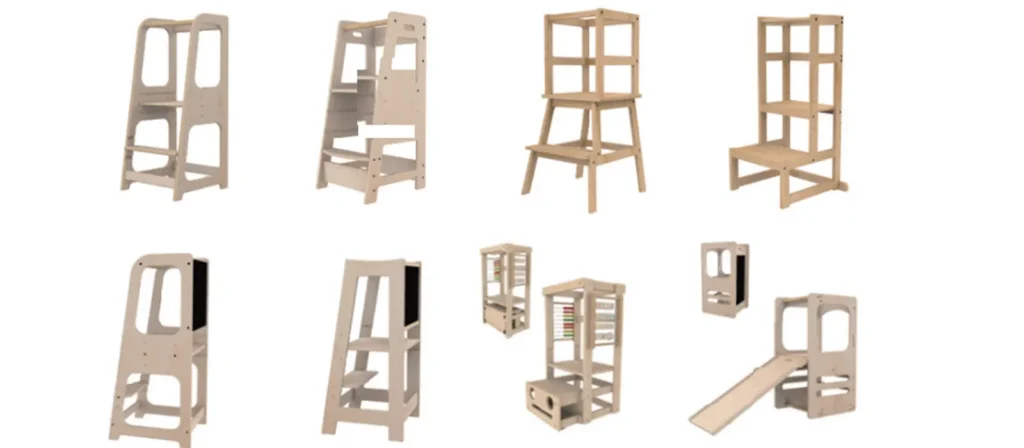
5. Montessori Pikler
The Pikler triangle is designed to help children develop strength, balance, and coordination through climbing and physical play, essential for gross motor skills. By allowing children to explore and challenge themselves at their own pace, the Pikler promotes confidence and an understanding of their physical capabilities. As a versatile piece of furniture, the Pikler triangle can be used in various ways to stimulate imaginative play, such as climbing, sliding, or creating forts. Children can engage with the Pikler triangle independently, learning to navigate their environment with minimal adult interference, fostering self-confidence and decision-making.
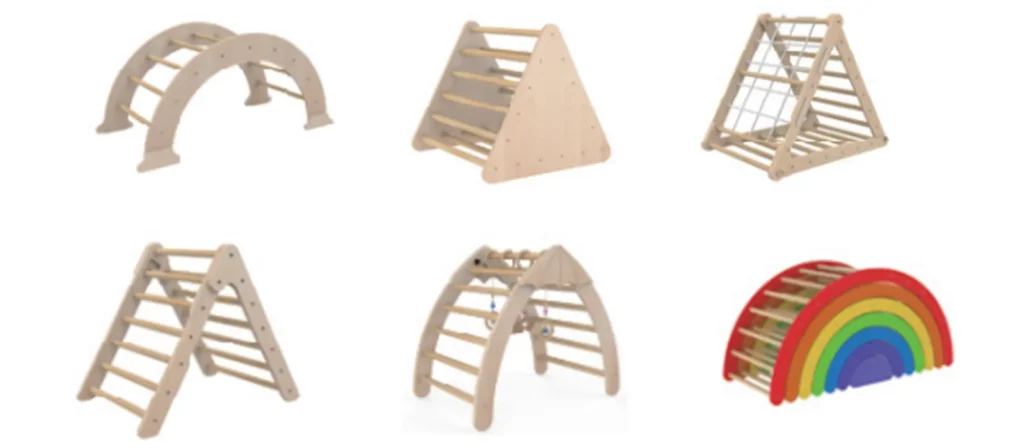
Each of these Montessori furniture pieces is designed to align with the principles of fostering independence, responsibility, and physical and cognitive development in young children. They create an environment that supports active, hands-on learning and encourages the child to engage with their surroundings meaningfully. If you want to buy Montessori furniture, you are welcome to contact us!
Transform Your Classroom with Custom Furniture Solutions
Reggio Emilia Furniture
Reggio furniture is typically light, flexible, and designed to encourage interaction. The classroom may have tables that can be easily moved to accommodate group work or different activities. Chairs and other furniture are often made from natural materials, emphasizing comfort and accessibility. Reggio Emilia classrooms are designed to be visually appealing and child-friendly, with inviting furniture that encourages exploration. The emphasis is on creating spaces that allow children to engage with one another and the materials. Furniture in Reggio Emilia classrooms helps facilitate the flow of learning, with a focus on flexibility and adaptability.
1. Reggio Emilia Tables and Chairs
Reggio Emilia classrooms often use tables designed for group work and flexible arrangements. These tables encourage children to work together, communicate, and share ideas, fostering social skills and cooperative learning. The tables and chairs are flexible and can be rearranged based on the needs of the project or activity, promoting an adaptable and dynamic learning environment that responds to the interests and development of the children.
Like Montessori furniture, Reggio Emilia’s tables and chairs are sized appropriately for young children, allowing them to sit, move, and organize their space independently, building a sense of responsibility. In Reggio Emilia, the classroom environment is considered the “third teacher.” With their simple, natural designs, the aesthetic qualities of tables and chairs help create a warm, welcoming space that inspires curiosity and creative expression.

Transform Your Classroom with Custom Furniture Solutions
2. Reggio Emilia Shelves
Shelves in Reggio Emilia classrooms are typically arranged in an orderly, thoughtful way, helping children understand the importance of organizing their environment. This also teaches them to respect their materials and keep the classroom tidy. Reggio Emilia places a strong emphasis on the aesthetic arrangement of materials. The open, accessible shelves not only create an inviting and orderly atmosphere but also promote a deeper engagement with the learning materials as children can visually and physically interact with them directly.

Both the tables, chairs, and shelves in a Reggio Emilia classroom contribute to creating an environment that promotes inquiry-based learning, collaboration, and independence. These furniture pieces are integral to fostering a sense of ownership over one’s learning experience and encouraging children to engage with the world around them in a meaningful way.
Transform Your Classroom with Custom Furniture Solutions
Conclusion
Both Reggio Emilia and Montessori offer wonderful opportunities for children to learn and grow. Ultimately, the right approach depends on your child’s personality and learning style.If your child thrives in a creative, expressive, and collaborative environment, Reggio Emilia might be the perfect fit. On the other hand, if your child benefits from structure, independence, and a clear path to mastery, Montessori may be more suitable.Both methods are rooted in a deep respect for the child’s autonomy, and both promote a lifelong love of learning. The best choice will align with your child’s natural tendencies and your family’s educational values.




